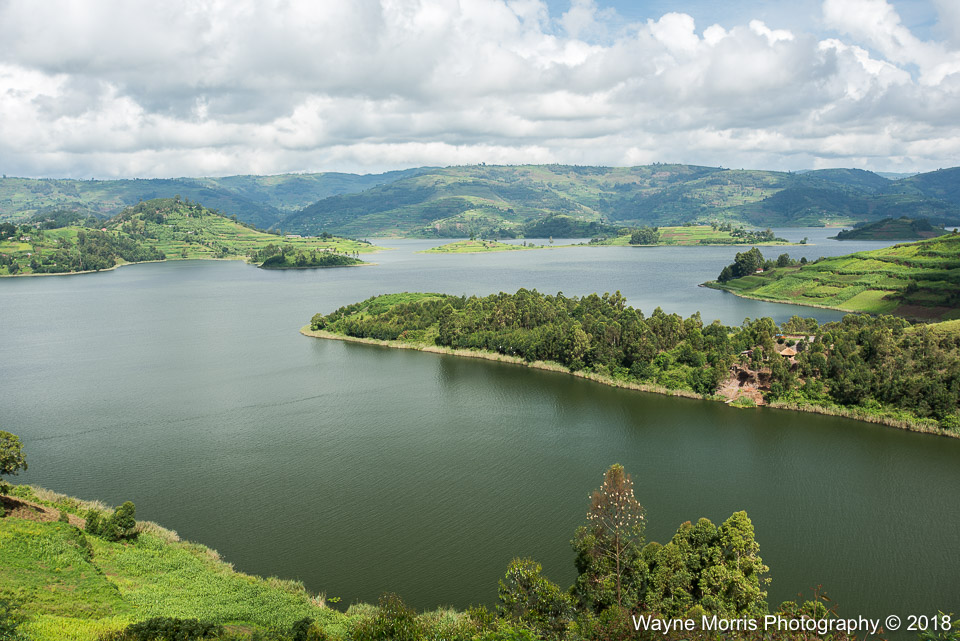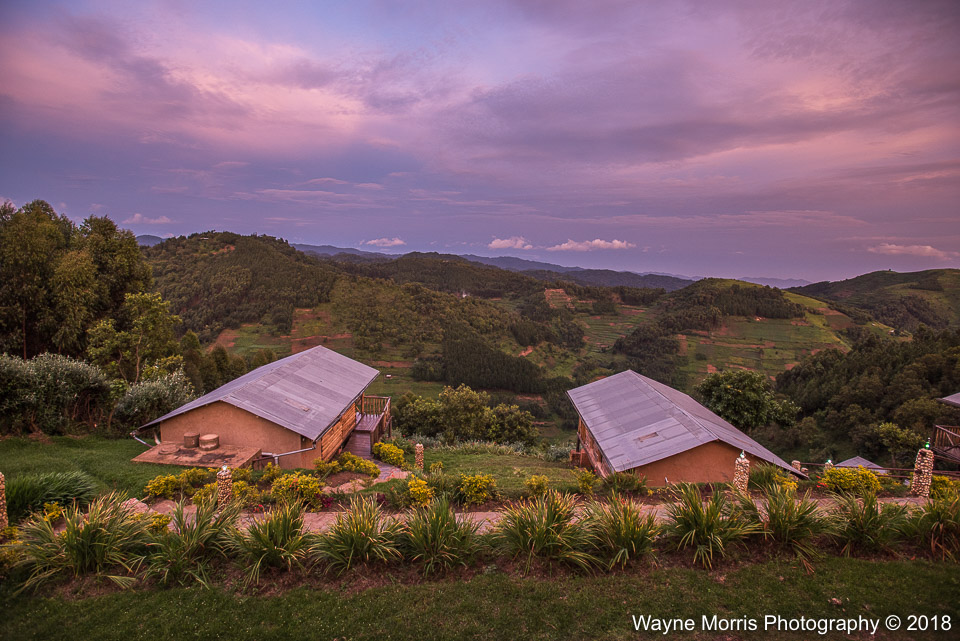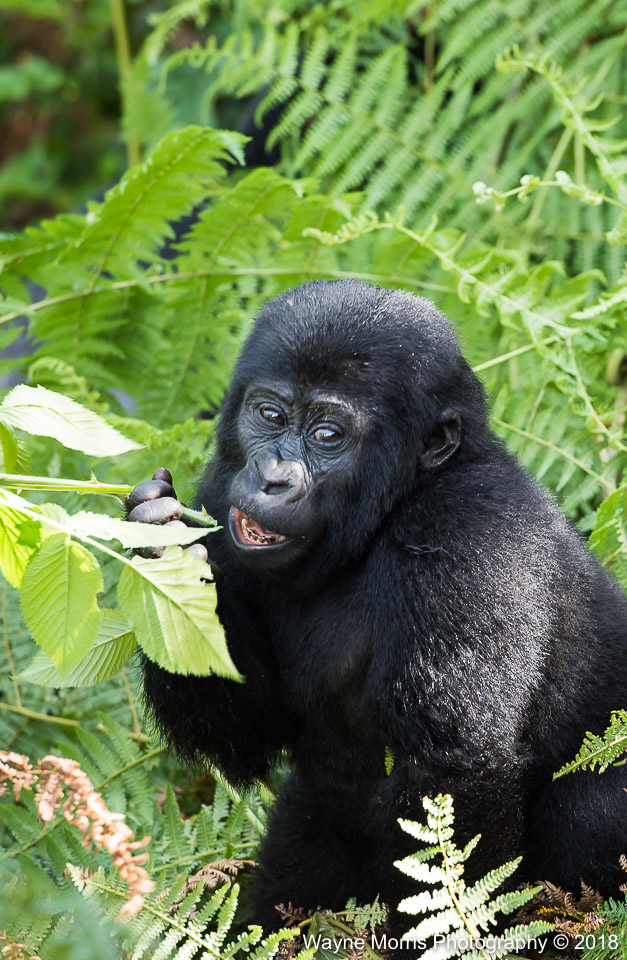Lake Bunyonyi
Around 3 hours after boarding the bus in Rwanda’s capital, Kigali, we were dropped by the roadside in the Ugandan town of Kabale – as planned a driver was waiting to take us the 11 kilometers to the Entusi Resort and Retreat Center boat pickup point on the shore of Lake Bunyonyi. We were both nervous about Andrea having no connectivity and the fact that we were about to head much further away from civilization. Although we didn’t manage to get a SIM card at least the banks were issuing Ugandan Shillings without any problems.
The road to the lake was heavily rutted due to the rains, remnants of the previous days landslides still showing. This caused our drivers car to take a battering and us to keep quiet about what we thought was a hefty fare. Walking would have sucked big time! Along pretty much the entire length of the dirt road were piles of small stones, apparently building supplies for local construction firms and house builders – these stones being the finished product from significantly larger rocks that barefooted women and occasionally children were chipping away at. It was hard to imagine the minuscule rewards from such tough labor.
We had no cause for concern – the resort had full solar power and a WiFi router that accepted previously purchased SIM cards (anyone that already owned a SIM card prior to the government shutdown of all new card registrations was fine). Andrea logged in to work and instantly had fast browsing, thankfully allowing us to now enjoy the 2 nights we had on this little piece of paradise. Our dates couldn’t have been better as we had the entire place and all its staff to ourselves.
Our entire stay for the 2 nights on a full board basis was $220, the only extras being alcoholic beverages and local tours. We couldn’t fault the price and knowing that Entusi Resort is part of a US based NGO and supports communities in the surrounding areas was a real bonus. This 3 day/ 2 night stay was definitely the best value for money experience on our Africa trip to date. Lake Bunyonyi has so much to offer and spectacular scenery abounds.
Disappointed to be leaving Bunyonyi but with the gorillas of Bwindi Impenetrable Forest beckoning it wasn’t so bad. This had been a bucket list item for a long time and although expensive it would have been too hard to visit Africa without heading off to see some close relatives. Most of our time in the central African region was planned for Rwanda, another country for gorilla tracking, but with their recent price hike from $750 per person to $1500 this was off the charts. The third option would have been Virunga in the Democratic Republic of Congo – coming in the cheapest at $400, but with the biggest chance of being kidnapped we didn’t really pay it too much attention. Uganda sat in the middle at $600 per person, with the lodge adding on an additional $50 to arrange and collect the permits before we arrived. This didn’t include transportation and would allow us to spend an entire hour with the group once we made initial contact!
We could easily have dropped many hundreds more Dollars on accommodation in the Bwindi area but after much research came up with Bakiga Lodge – situated on the east side of the park it wasn’t too difficult to get to from Kabale and being an NGO made us feel like responsible tourists. The three nights full board lodging and Gorilla permits came in at $1850 total for the both of us, a little on the hefty side but a fraction of what some people pay. Another $85 each direction would pay for a driver to collect us from Bunyonyi and take us the three hours up to Bakiga, supposedly on really crappy roads – when we were met by a driver with a car it surprised us. How bad could the road conditions really be and couldn’t we just have rented a vehicle and had freedom for less? Oh well, it was nice not to have to be concerned with road conditions and let someone else’s car take a beating.
It didn’t take much walking to discover that as well as small stores along the principal road there were also a couple of orphanages – see Donations Welcome post. However little the children of these parts of the world have they are always happy, smiling and eager to meet foreigners. We were often called out to and asked to come visit them, something we always did, not only to gain an insight into the lives of others far less fortunate than ourselves but also to see how we could help. Sadly it seemed that for all the rich tourists that come to Bwindi primarily to see mountain gorillas very few ever make it to the places that matter, places where children live in extreme conditions, many with no family, and all crying out for assistance! There was no way we could leave without promising to help.
A magnificent sunset the night before our gorilla tracking was hopefully a good indication that the rains would stay away. We knew that this was early season and that the downpours had not long subsided, however neither of us could think of how miserable it would be to spend anything from a couple of hours up to the entire day in a wet, muddy, and slippery forest. And then there was also the possibility that we would never find the mountain gorillas – now that would really suck! As it happened the day stayed dry and we did get to spend over an hour with the amazing creatures.
After a short briefing about gorilla etiquette our small group were off, at first driving along dirt roads whilst trying to find out from trackers where the Mukiza group was located, soon turning around to head back from where we had come. The group was closer than expected and with an armed guard leading the way we headed along well worn trails into the forest. Barely an hour later we ditched our small packs and were told that our hour was about to begin – looking up into the trees we realized why. A family of twelve gorillas made up of infants, subadults, adults and the silverback leader were making their way from the upper branches to the ground, the moment we had excitedly been waiting for. Being oblivious to us the group led by the silverback were off, apparently in search of food which makes up a huge part of their day, our small group in hot pursuit – where the gorillas went we went, although a lot more clumsily. Our trackers had been out since the extreme early hours in search of this group and now continued to machete a way through the thick undergrowth to allow us to get short glimpses as the majestic primates went about their day.
At times the chase, however exciting, was extremely frustrating as the gorillas never stayed still – what is it with wild animals! We were tripping over vines, slipping and sliding over the hilly terrain, all whilst trying to snap photos in the forests low light conditions. After thirty minutes of this the silverback must have realized our annoyance and took the group from feeding mode to resting mode – they all became still in an area with far less undergrowth as if understanding our need for good shots. The second half of our one hour with the gorillas was spent mere feet away from the huge silverback and his loyal group members. What we were witnessing was truly amazing, wild animals capable of killing us in a heartbeat, accepting us being so close.
As of the recent 2018 census the mountain gorilla population in central Africas Virunga Massif area has grown to more than one thousand, a 25% increase since 2010. If paying hefty permit fees helps with the protection and research of this amazing primate then it was money well spent, and if like what we heard rumored about expansion of gorilla habitat then even better. Very highly recommended!
Beyond Gorillas
Although gorillas were the highlight of the area we also got to see L’hoerst monkeys, colobus monkeys, and a variety of bird species whilst out walking, none incurring expensive permits or park entry fees. Hiking opportunities along miles of quiet dirt roads were endless, meandering up and down hillsides passing by friendly men, women and children washing clothes, carrying water and tending to fields of crops. On this occasion we were forced into a very short visit, Uganda definitely requiring far more exploration in the near future.
Not available to foreigners at time of visit
Transportation
Arrival: Kigali -> Kabale, Carrier: Bus, Cost: $cheap pp
Departure: Kisoro -> Ruhengeri, Carrier: Minibus, Cost: $cheap pp
Bwindi transfer: Lake Bunyonyi -> Bwindi -> Kisoro, Carrier: Private shuttle, Cost: $85 pp
Dates
May 2nd – May 7th 2018






















